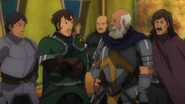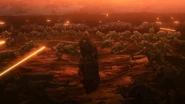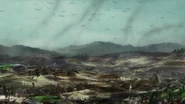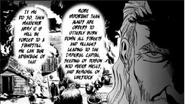| ||||||||||||||||||||||||||||||||||
Second Battle of Alnus Hill was the second battle the Japan Self-Defense Forces fought in the Special Region, after the First Battle of Alnus Hill which ended in a decisive defeat for the Empire and a dramatic weakening of Imperial military might and political standing due to severe casualties.
The Second Battle of Alnus Hill is considered to be a mass slaughter for the Allied Force rather than an actual battle.
Prelude[]
After its victory at the Battle of Ginza, the Japan Self-Defense Forces sent its forces into the Special Region, where Imperial soldiers were waiting. During the First Battle of Alnus Hill, the Empire suffered total losses due to their archaic weaponry and tactics. With the Imperial Military now reduced by 60% and a growing pro-peace faction in the Imperial Senate, Emperor Molt Sol Augustus gathered a second army of 100,000 soldiers provided by his vassal states, including Elbe, Mudwan, Alguna, and Ligu. These forces were ostensibly sent to repel the invaders and send them back across the Gate. In truth, Augustus knew the JSDF was far more powerful than his allied armies, and in fact, sent his rivals with the intention that they would be killed in battle, thus minimizing the chances of rebellion.
At first, the leaders of the Allied Army were confident that they could win the battle easily because they outnumbered the JSDF 30 to 1, along with the fact that they had never witnessed the strength of their opponents first-hand. Only Duran was wise enough to take caution, as he had been aware of how 60,000 men had easily been routed from Ginza in a matter of hours with massive casualties on their side, though despite this he was still confident he could defeat the enemy.
Offensives[]
Allied Kingdoms' 1st Offensive[]
The armies of Mudwan, Alguna and League marched to the JSDF positions at day, consisting of their human forces and demi-human auxiliaries. They ignored the signs posted by the JSDF, which were written in Imperial language so they could understand. As a result of entering the fire-zone and ignoring the warning signs, the JSDF marked them as hostile and launched an artillery barrage on the fire-zone position. The armies of Alguna, Mudwan and League were quickly decimated, with Duke Ligu himself horrified by the power of the JSDF before too was killed by the barrage. In total, 10,000 men were killed in this assault.
Duran and his men slowly arrived to reinforce their armies, but found Alnus Hill "erupting" and upon arrival, did not find a single survivor, including the Kings of Alguna, Mudwan and the League's forces. They decided to temporarily withdraw to form another plan.
Allied Kingdoms' 2nd Offensive[]
The Allied Army began a second assault with even more soldiers, believing that their sheer numbers would be able to overwhelm the numerically inferior JSDF. This time, dragon riders were also added into the fray, believing that the JSDF did not have enough anti-air capability. Much to their horror, the JSDF used Type 87 mobile anti-aircraft guns to quickly mow down the dragon riders, while the ground forces were destroyed by a combination of light machine guns, entrenched Type 74 tanks and artillery barrages. In total, 40,000 men were killed in this assault, and the Allied Army retreated again.
Allied Kingdoms' 3rd Offensive[]
The surviving nobles and officers fell into despair, as they had lost half of their army fighting a foe that did not even suffer a single casualty at all. They wondered where the Imperial Army was, and if they should retreat. Duran decided not to retreat, as he wanted to avenge Duke Ligu's death and hoped to inflict a single casualty in revenge, and opted for a night raid, believing the JSDF would be sleeping.
Duran made his move in the night, and all troops slowly converged onto the JSDF encampment. However, they were soon detected by Illumination shells, which Duran noted was extremely bright. Realizing that his tactics had been compromised, Duran ordered all of his men to charge, who were simply stunned by the light emitted by the shells. His horse then got caught on some barbed wire, and the rest of Duran's men arrived to get him back up on his feet, applying a tortoise formation around him. Duran immediately shoved his men out of the way and ordered them to run, but the JSDF soon began pelting the area with light machine gun fire and artillery strikes, easily killing all of his men in seconds.
Duran wondered how everything could have fallen apart and grabbed a bow and arrow from a fallen soldier before firing. The arrow most likely did not hit anyone, as Duran himself stated that he hadn't reached the halfway point when they were destroyed. Duran was then struck by an artillery strike, losing his left arm and leg, but survived; the Empire thought otherwise, and he was presumed dead by them. This near-death experience turned Duran's black hair into ghostly white. 
Aftermath[]
After the battle, the bodies of the troops of the Allied kingdoms were presumably buried in a mass grave by the JSDF using heavy excavating machinery. At the same time, the JSDF began construction of a more permanent base at Alnus, including in it defensive walls and machine gun nests, barracks, command posts, armories, supply warehouses, motor pools, and even an air base.
When Emperor Augustus heard the news of the defeat, he ordered a scorched earth campaign in an attempt to slow the JSDF advance. This was the official reason for the order. In actuality, it was to further weaken the vassal states and make them unable to rebel against the Empire. However, the tactic did little to none to the advance of the modern, mechanized, and highly mobile JSDF forces since Molt had no ideas about the knowledge of modern vehicles as he assumed the JSDF used horses. Additionally, due to Molt's lack of understanding of modern warfare and tactics, he never realized that the conventional resources of Special Region meant extremely little to none for the JSDF since modern warfare emphasizes on swift attacks and retreat, along with a singular supply location, meaning that the JSDF did not bother to take any resources from the areas they passed by.
Consequently, his shallow strategy also causes a large portion Imperial citizen to outright despise him and the Empire in which they began to side and support the JSDF plus the fact that he damages the tax income and food sources of the Empire for no good reasons. Finally, he also proposed to build strongholds at various locations to force the JSDF to bleed and crumble under the pressure, though he failed to realize the JSDF could easily destroy them with their technology.
After the defeat, the Empire lost significant amounts of military and political power and was no longer able to control the area surrounding the Gate, including the village of Coda and the city of Italica. Both of these cities quickly fell under the JSDF sphere of influence in the Special Region. Many survivors of the vassal states deserted and became bandits, who later attempted to seize control of Italica but were promptly defeated with JSDF aerial support. Furthermore, due to all the soldiers of the Allied Army having their own money with them, and the JSDF not collecting them, the Empire suffered a wealth crisis shortly afterwards.
As King Duran of Elbe managed to figure out Molt's scheme, he and the rest of the ruling families of the vassal states wanted some payback from the Emperor for tricking them into the butchery. Their chance of revenge finally came after Itami killed the Flame Dragon. After the Battle of Mount Tube, Itami was given multiple awards, knighthoods, and aristocratic titles of nobility. Duran also gave the JSDF access to numerous mining locations. By the end of the Imperial Civil War, it apparently had become common knowledge in how immeasurably strong, in the military standards of the Special Region, the JSDF are as the former vassal states such as Mudwan, League Principality, Alguna and Elbe, after declaring independence, could have easily wiped out the remnants of the Empire, to further satisfy their revenge, but they chose not to because the JSDF would easily wipe them out if they did.











































